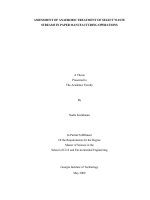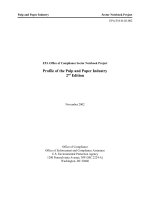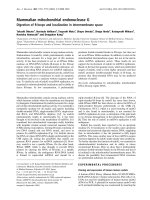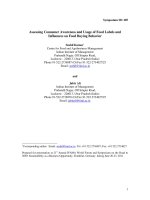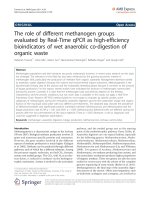Continuous Anaerobic Digestion of Food Waste and Paper Waste under Mesophilic-Dry Condition
Bạn đang xem bản rút gọn của tài liệu. Xem và tải ngay bản đầy đủ của tài liệu tại đây (206.86 KB, 10 trang )
Journal of Water and Environment Technology, Vol. 8, No.3, 2010
Address correspondence to Sae-Eun Oh, Department of Environmental Engineering, Hanbat National
University, Email:
Received December 9, 2009, Accepted April 6, 2010.
- 167 -
Continuous Anaerobic Digestion of Food Waste and
Paper Waste under Mesophilic-Dry Condition
Dong-Hoon KIM*, Mo-Kwon LEE**, and Sae-Eun OH**
* Bioenergy Research Center, Korea Institute of Energy Research, Daejeon 305-343, Republic
of Korea
** Department of Environmental Engineering, Hanbat National University, San 16-1,
Duckmyoung-dong, Yuseong-gu, Daejeon 305-719, Republic of Korea
ABSTRACT
With increasing concerns regarding the limited capacity of landfill, conservation of resources,
and reduction of CO
2
emissions, dry anaerobic digestion of organic solid waste has recently been
gaining considerable attention. However, there have been few reports on continuous operation
and most have involved operation under thermophilic condition. In the present study, a
continuous dry anaerobic digestion system treating a mixture of food waste and paper waste was
operated under mesophilic condition. For easy injection of a solid type substrate, the feed was
diluted six-fold with the sludge inside the reactor, and then, fed into the reactor. During the
operation, hydraulic retention time (HRT) decreased as follows: 150, 100, 60, 40, and 30 d at a
fixed substrate concentration of 30% total solids (TS), corresponding to a solid loading rate
(SLR) of 2.0, 3.5, 5.0, 7.5, and 10.0 kg TS/m
3
/d, respectively. Up to 40 d of HRT, biogas
production proportionally increased as SLR increased, but at 30 d of HRT, biogas production
decreased. At further operation, instead of controlling HRT, substrate concentration was
increased to 40% TS, which was found to be a better option for increasing the treatability. The
system could achieve a stable CH
4
production yield of 0.27 m
3
CH
4
/kg TS
added
and 0.25 m
3
CH
4
/g COD
added
, and over 75% of volatile solids (VS) reduction.
Keywords: dry anaerobic digestion, hydraulic retention time, mesophilic, methane
INTRODUCTION
In order to mitigate the effects of climate changes, the Kyoto Protocol was announced in
1997, dictating that industrialized countries should reduce their total greenhouse gas
(GHG) emissions by 5.2% by the end of 2012 from the level of emissions in 1990. This
target can only be met with a significant transition from fossil fuels to alternative energy
sources that are cheap, renewable, and not causing pollution (Saxena et al., 2009). Tidal,
geothermal, hydroelectric, and wind power could be the suitable candidates in some
countries; however, they are not expected to become the dominant sources in the future
(Zidansek et al., 2009). Meanwhile, biomass is widespread throughout the world, and
thereby is not subject to world price fluctuations or supply uncertainties, in contrast with
imported fuels. In addition, it is a carbon neutral resource in its life cycle (Fortman et al.,
2008).
The use of landfill has been the main final disposal method of organic solid wastes to
date in most nations. However, as it creates a large amount of polluted leachate, emits
GHG, and requires a long time (30-100 yrs) for degradation, the need to avoid landfill is
now shared by all technical communities (Gioannis et al., 2009). Considering these
aspects, the choice of a biological process seems obvious. In this regard, anaerobic
digestion perhaps offers the best solution in terms of energy and mass balance (Pavan et
al., 2000). Through anaerobic digestion, biomass including organic solid waste can be
- 168 -
stabilized in a closed reactor where biodegradation is highly accelerated relative to that
in a landfill. Furthermore, clean biogas can be obtained, which can be utilized for heat
or electricity generation. In addition, the effluent sludge may be composted or may be
used for soil conditioning depending on its characteristics (Vallini et al., 1993).
However, as the conventional anaerobic digestion method proceeds under a slurry state
(<5% total solids – TS), a large amount of external water is required for diluting solids.
This will not only increase the energy consumption for digester heating and feed slurry
pumping, but also the volume of digester effluent that should be dewatered (Radwan et
al., 1993). To overcome these drawbacks, dry digestion or “high-solid digestion” can be
employed, in which a solid substrate having over 20% of TS concentration is directly
fed to the reactor (Bolzonella et al., 2003).
During the 1990s, dry digestion prevailed over wet digestion, and several
commercialized dry digestion systems e.g. DRANCO (Six and De Baere, 1992),
KOMPOGAS (Willinger et al., 1993), and VALORGA (Laclos et al., 1997) were
developed. Various kinds of solid wastes such as agricultural residues, sludge cake, and
organic fraction of municipal solid wastes have been treated. Recently, with increasing
concern over the limited capacity of landfill, conservation of resources, and reduction of
CO
2
emissions, dry digestion is gaining much attention. However, most researches have
been limited to batch tests or investigation of the start-up period, and all the systems
have been operated under thermophilic condition, based on thermophilic operation (50-
60°C) being favorable in terms of hydrolysis and microbial kinetics (Forster-Carneiro et
al., 2007; Shuguang et al., 2007; Forster-Carneiro et al., 2008a; Forster-Carneiro et al.,
2008b). It is important, however, to attain the maximum treatability of the system, and it
is clear that the operation at mesophilic condition (30-40°C) would be less energy
consumptive, thereby enhancing economic viability.
In Korea, the amount of waste dumped to landfill has reached 10.5 million tons per year,
accounting for 11.2% of total waste produced in 2007. Considering the increasing trend
of waste production and the current remaining landfill capacity of 185 million tons, it is
expected that the nation’s landfill will be filled within 10 years. Also, Korea is a highly
energy-dependent country, fulfilling 97% of its energy consumption needs by import,
and will be forced to reduce CO
2
emissions in the near future under the Kyoto Protocol.
Therefore, implementation of anaerobic digestion for the treatment of organic solid
waste is an urgent issue.
In the present work, the performance of a continuous dry anaerobic digestion process
under mesophilic condition was investigated. A mixture of food waste and paper waste,
the main sources of municipal solid wastes, was used as a feedstock. During the
operation, hydraulic retention time (HRT) and the solid concentration of substrate were
controlled.
- 169 -
MATERIALS AND METHODS
Feedstock and seeding source
Food waste collected from a school cafeteria, and paper waste comprised of toilet paper,
newspaper, and copy paper were shredded by a hammer crusher (TOP-03H) and cut
crusher (TOP-03-CC), respectively, to a size less than 5 mm. Both crushers are
manufactured by Korean Mechanics Engineering Corp. The mixing ratio of food waste
and paper waste was 7:3 on a weight basis and a certain amount of water was added to
adjust the TS concentration. The TS concentration of food waste and paper waste was
20% and 99%, respectively. Volatile solids content (VS/TS), total nitrogen (TN), and
chemical oxygen demand (COD) concentration of the mixed feedstock were 94.5±0.9%
(VS/TS), 0.014±0.004 g/g TS, and 1.09±0.10 g COD/g TS, respectively.
As a seeding source, a mixture of dewatered sludge cake and anaerobic digester sludge
taken from the same local wastewater treatment plant was used. The characteristics of
these two different types of sludge are presented in Table 1. Dewatered sludge cake and
anaerobic digester sludge were mixed at a 4:1 ratio by volume basis, resulting in initial
TS and VS concentration of 17.3% and 7.6%, respectively.
Table 1 - Characteristics of seeding inoculum used in this study
Item Dewatered sludge cake
Anaerobic digester
sludge
TS concentration (%) 20.2 5.8
VS content (VS/TS, %) 40.2 95.0
Alkalinity (g CaCO
3
/L) 16.3 2.8
TN (mg N/L) 5,200 1,900
Ammonia (mg NH
4
-N/L) 2,950 980
pH 8.5 7.6
Reactor operation
As shown in Fig. 1, a horizontal-type cylindrical reactor was used for dry anaerobic
digestion. The total volume of the reactor was 60 L with a diameter and length of 320
mm and 750 mm, respectively. The broth was agitated by four impellers at 25 rpm.
Thirty liters of seeding source was added to the reactor, and purged with N
2
for 10 min
in order to provide anaerobic condition. After three days of adaptation period (no feed
injection), 0.27 L of substrate (30% TS), corresponding to 150 d HRT, was fed daily.
There was no sludge injection until the inside sludge volume reached an effective
volume of 40 L. At further operation, HRT was decreased to 100, 60, 40, and 30 d at a
fixed substrate concentration of 30% TS. The substrate was added once daily until 60 d
HRT, but the injection time was increased to twice daily at further HRT decrease. As a
decline in system performance was observed at 30 d HRT, the HRT was again increased
to 40 d for performance recovery. Substrate concentration was subsequently increased to
40% TS at 40 d HRT.
In this study, for easy injection of a solid-type substrate, the feeding pump was turned
on after the solid content of the substrate was reduced by dilution with some sludge
inside the reactor. The same screw-type pumps were used for feeding the substrate and
recycling the sludge inside the reactor. Further details are provided in Table 2. In order
to optimize this process, 0.3 L (= 1Q) of substrate was mixed with 2-6 times recycled
- 170 -
sludge (2Q-6Q), and the pump was then turned on. This test was conducted during the
100
th
-120
th
day of continuous operation. All the systems were installed at a
temperature-controlled (35±1°C) room.
Fig. 1 - Schematic diagram of anaerobic dry digestion system
Table 2 - Details of screw-type pump for feed injection and sludge recycling
Model
Output
(W)
Voltage
(V)
Frequency
(Hz)
Current
(A)
Starting
torque
(N·m)
Rated
torque
(N·m)
Max.
speed
(rpm)
K9IP200FH 200 220 50 1.3 3.0 1.45 1,350
Analysis
Measured biogas production was adjusted at standard temperature and pressure (STP),
0°C and 760 mmHg. The contents of CH
4
, N
2
, and CO
2
were determined by gas
chromatography (GC; Gow Mac series 580) using a thermal conductivity detector and a
1.8 m 3.2 mm stainless-steel column packed with porapak Q (80/100 mesh) with
helium as a carrier gas. The temperatures of injector, detector, and column were kept at
80, 90, and 50C, respectively. Volatile fatty acids (VFAs, C2-C6) and lactate were
analyzed by a high-performance liquid chromatograph (HPLC; Finnigan Spectra
SYSTEM LC, Thermo Electron Co.) with an ultraviolet (210 nm) detector (UV1000,
Thermo Electron) and a 100 mm 7.8 mm fast acid analysis column (Bio-Rad Lab.)
using 0.005 M H
2
SO
4
as a mobile phase. The liquid samples were pretreated with a 0.45
m membrane filter before injection to the HPLC. Alkalinity, pH and concentrations of
TS, VS, COD, TN and ammonia were measured according to Standard Methods (APHA,
at el. 1998).
RESULTS AND DISCUSSION
Continuous operation performance
In order to treat solids with high concentration, highly concentrated biomass should also
be prepared. Generally, however, wet digester sludge having less than 5% VS
- 171 -
concentration has often been used as a seeding source, requiring a long period to build
up a highly concentrated microbial consortium (Forster-Carneiro, 2007; Fernandez et al.,
2008; Montero et al., 2009). Instead, dewatered sludge cake having 8% VS
concentration was used as the main seeding source in this study. It appears that this
strategy was successful; CH
4
production was observed from the first day, and biogas
production was stabilized within 30 d (Fig. 2).
Time (day)
0 100 200 300 400
Biogas production (L/d)
0
50
100
150
200
250
Solid loading rate (kg TS/m
3
/d)
0
2
4
6
8
10
12
Biogas
SLR
HRT
= 150d
HRT
= 100d
HRT
= 60d
HRT
= 40d
HRT
= 30d
HRT = 40d
HRT
= 40d
Substrate conc. = 30% TS
Substrate conc.
= 40% TS
Fig. 2 - Daily biogas production of mesophilic-dry anaerobic digestion of organic solid
wastes at various operating conditions
However, in employing this strategy, special care should be taken with regard to
ammonia inhibition, because dewatered sludge cake is rich in nitrogen, being degraded
into ammonia during the digestion, and there does not exist any nitrogen removal
mechanism in anaerobic digestion. In this study, fortunately, ammonia concentration
during the start-up period did not exceed 3,500 mg NH
4
-N/L, and as the substrate was
continuously supplied, its concentration gradually decreased to a range of 1,500-2,500
mg NH
4
-N/L. If the dewatered sludge cake contains a high concentration of ammonia,
its removal by stripping or applying other tools prior to seeding is strongly
recommended.
Until the 336
th
day of operation, HRT was decreased to 150, 100, 60, 40, and 30 d at a
fixed solid concentration of 30% TS, corresponding to SLR of 2.0, 3.5, 5.0, 7.5, and
10.0 kg TS/m
3
/d, respectively. At the 171
st
-175
th
d period, immediately after the HRT
transition from 60 d to 40 d, a sudden decrease of biogas production was observed. It

